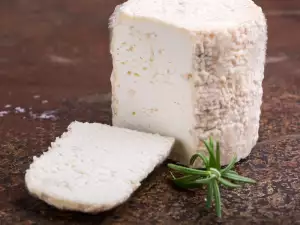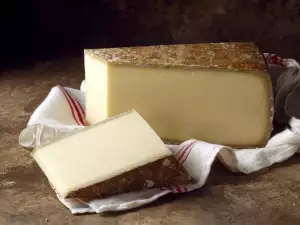Many cheeses have their own legends, with giants, cyclops, sword fights, the moon and other fairy tales. A very interesting legend is connected with the round and very hard French Mimollette cheese.
Legend has it that Napoleon was in a fierce battle against the Prussians when he suddenly ran out of cannonballs. He reached for the next best thing, a wheel of Mimolette cheese, which he loaded the cannons with and let them fly to great effect. It wasn't the main reason Napoleon won the battle, but it certainly helped his army live to fight to the end.
The astonishing facts about this curious and delicious-looking cheese show that the legends about it have their basis in reality. Let's track it down.
The history of Mimollette cheese
Mimolette is a hard cow's milk cheese that is produced in Normandy, Brittany and other parts of France. Some say it originated in Lille, France, while others believe it was first made in the Netherlands.
Mimolette cheese can be traced back to the 17th century, specifically to the reign of King Louis XIV. His prime minister, Colbert, banned the importation of many foreign goods, such as Edamère cheese. In Flanders, the northernmost region of France, where the peasants had strong cultural ties to the Netherlands, Edamer was particularly sorely lacking. Even today Dutch can be heard spoken as a first language in this part of France. And so Edamer was smuggled into France against the king's decree.
In time, defiant French subjects began making their own cheeses from the same basic recipe. Of course, the French added a bit of flair. Craftsmen changed the shape and color. They smoothed the top and bottom and then added a natural dye known as annatto, which provides a color ranging from melon or carrot to a bright rich tangerine. Mimolette is named after the French Edamère, although there are certain differences between the two.
Characteristics of Mimollette cheese
An important difference between Mimollette and the original Edamer is the milk. Comparing the two shows how the different breeds of cows and the grasses and herbs they feed on change the flavor of the cheese. Mimollette's intensely fruity and nutty flavor makes it popular as a snack with a glass of beer.
Mimolette cheese is popular throughout France among both novices and connoisseurs of cheese. This is a good starter cheese and is also suitable for children. It is also called Boule de Lille.
Boule translates as a ball, spoon or bowl and Lille is the location of the cellars where the cheese first ripened. This tasty treat can be eaten young, but unlike Edamère, it is usually aged for a minimum of six months. The texture is hard and greasy and the color is bright orange.
As it ages, it slowly hardens and dries and the color changes from carrot to orange-brown. At twelve months it is called mature and at two years it is very mature. It has a firm texture with a very nutty flavor and a thick brown-gray skin.
Essentially Mimolette is an extremely unusual cheese, spherical like Edamère but with a rough surface like a moon and a bright orange interior. When cut, it looks like a melon.
Each Mimollette cheese is 20 cm in diameter, weighs between 3 and 4 kg and has a fat content of 40 percent. All brand name cheeses are made from pasteurized cow's milk.

Obtaining Mimolette Cheese
If you look at a piece of Mimolette in a store with a magnifying glass, you see a bunch of crumbs that are constantly moving, little specks that sometimes bounce. These are cheese mites. These are microorganisms that exist everywhere, but they especially like the moist, cool atmosphere in the cheese aging chamber. They gather on boiled, pressed Mimolette-like cheeses, break through the rind, move steadily toward the softer center, leaving behind a floral, sweet aftertaste.
If left to their own devices, the cheese mites will take over the piece, until it becomes inedible. Many hard types of cheese are treated to deter cheese mites. For example, the rind of Parmesan is buttered and Cheddar is traditionally wrapped in cloth. From Mimollette they are just brushed off.
Cheese mites are so small that they usually cannot be detected with the naked eye. Their presence is detected by a very fine brownish powder on a wheel of cheese. Cheesemongers joke that if you brush the dust off the rind of a wheel of cheese and move it to a new place a few hours later, the cheese is infected with mites. This dust is actually an accumulation of live mites, dead mites, their secretions and cheese residue. It sounds unappetizing, but it's really quite harmless, except for a severe dust mite allergy. Mites are present in all types of dry products, such as grains and flours, without causing direct harm to people.
The mites are present on the outside of hard cheeses like Cheddar and Mimolette. They can usually be brushed off the rind of the cheese without affecting the flavor inside. Some people even believe that the mites give the cheese more flavor, as is the case with Mimolette. And so these microscopic creatures are part of the cheese aging process. Biting mercilessly into the cheese, they get stuck in the rind, aerate the product and drastically reduce its volume. The result is a dense, salty cheese with earthy, sweet, almost caramel undertones.
One of the key factors in limiting mite damage is early intervention, the mentioned brushing or dusting the outside of the cheese. According to one cheese expert, this product is a living thing. Some have blue mold, some have white color, some have a few mites. All contribute to the flavor development.
Harms from Mimolette cheese
Scientists aren't quite sure how Mimolette mites give cheese its nutty, fruity aroma and flavor. Perhaps the mites themselves have a nutty and fruity taste. We know that the flour mite is used purposefully to make Mimolette cheese and other specialty cheeses, but apparently cheese mites are pests in some cheese storage facilities.
They grow in conditions higher than 4°C and 60 percent humidity, which are common storage practices for cheese ripening. They can also carry allergens, which is why Mimolette cheese is banned in the US as allergenic.
Mimolette cheese in cooking
Mimolette is one of the delicacy French cheeses. France's fame as a cheese paradise is also largely due to Mimollette.
Without a doubt, this dairy product is an excellent choice for people who do not follow a vegetarian diet. The orange cheese, thanks to the annatto, has a tempting buttery, salty and nutty flavor and 40 percent fat, making it an ideal addition to salads, omelettes, soups, to pasta recipes and other cooked dishes.
The most mature Mimolette is particularly liked in its ultra-hard state and taste close to hazelnut. Its firm texture and aroma make it an excellent wine option. It pairs best with merlot and sherry, as well as any sweet dessert wine. Young red wines also pair well with this cheese, as does strong beer.
If you want to know more types of delicious French cheeses, have a look at some information about - Brie cheese, Roquefort, Beaufort cheese.



















Comments